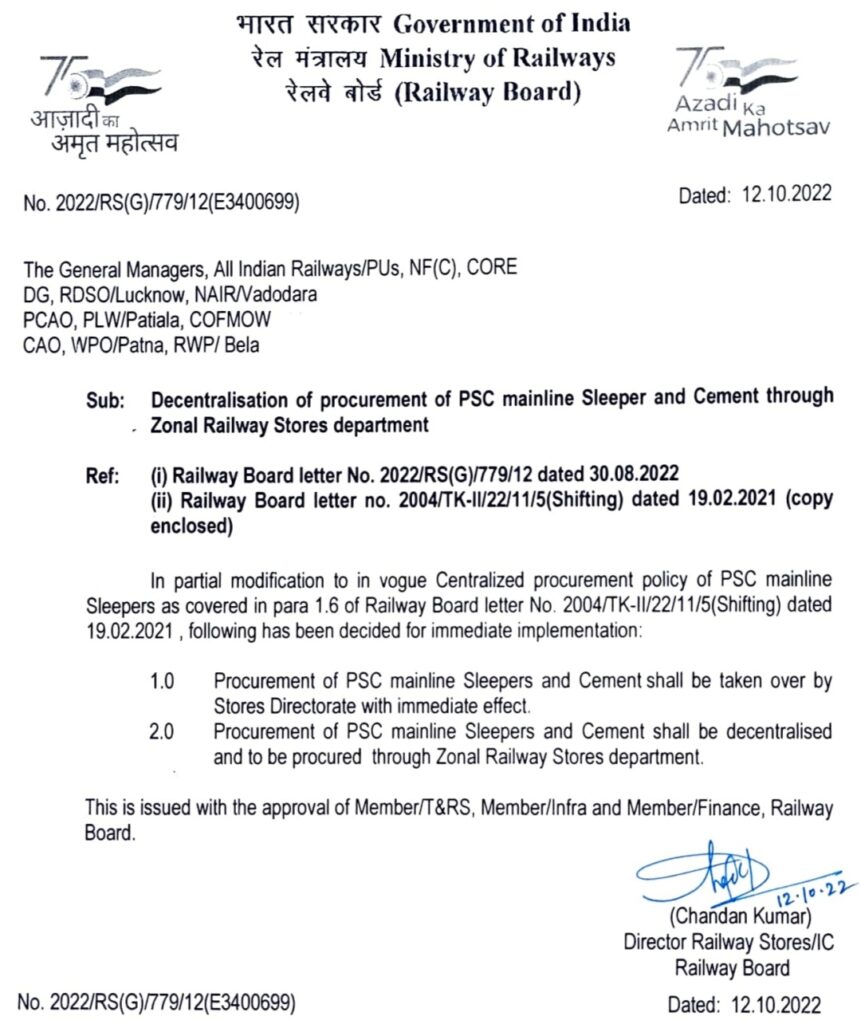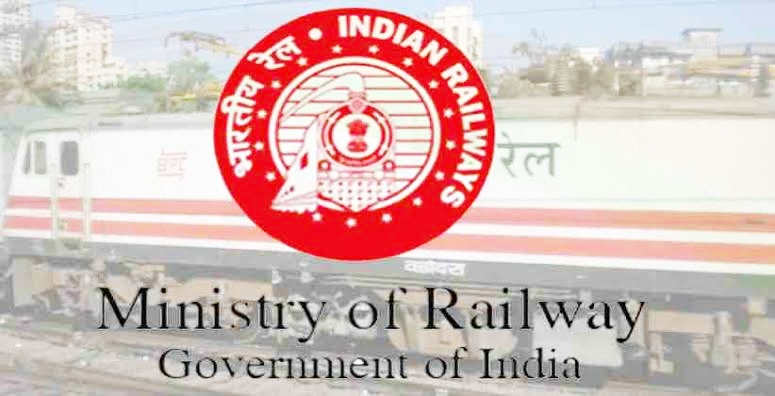Step Backwards or Policy corrupt system?
Is this again a case of poor advice by looking after officers, who have no experience of the domain they are heading-they just cannot understand the implication of decisions they are taking?
Why not they take leaf from our Prime Minister who is full of ideas on using IT to create transparency and leverage economies of scale!
Railway Board issued a major policy change vide their letter no. 2022/RS(G)779/12(E3400699) of 12th October, 2022. This has two dimensions:
1. Long established Policy of centralised procurement of PSC Mainline Sleepers has been dispensed with,
2. The stores department will now be responsible for the purchase of PSC Mainline Sleepers in Zonal Railway level like other stores items.

This decision has shocked railway experts and senior officers who have extensive experience of running Railways and handling projects. #Railwhispers requested these officers to give their inputs and also took feedback from officers we believe are aware of circumstances which led to this decision.
Based on inputs from Railway Board and Zonal Railways let us first analyse the decision-
Civil Engineering department has created a very robust system of decentralised Sleeper plants which are near the consumption centres.
These plants are capital intensive and their design evolved when railways decided to migrate to PSC Sleepers.
A major step to improve Railway Safety and reduce maintenance costs.
These plants were loaded with orders by Railway Board which processed Sleeper orders centrally after collecting requirements from all consumption units in Zonal Railways and Construction Organisations.
These plants were fed by Steel and Cement from nearest plants, orders of these raw materials were also handled centrally.
This mechanism not just squeezed prices of manufacturing but also of the raw material.
Principle followed has been:
Order from a level which has highest leverage. By this policy, railways have voluntarily given up its biggest leverage – experts say.
Decentralisation immediately takes away economies of scale from the table. Small railways and units have smaller requirements, unlike larger railways and larger construction units.
It is not clear how can rates be kept the same? It is well known that store tenders cannot be decided on differential rates across Zones easily.
How will raw material cost be optimised? How can railways away from steel plants negotiate well?
Stores officers admit that cost will surely increase but the increase in smaller consumption units will be disproportionately higher.
Other practical advantages of dealing the issue at Railway Board were:
Key fear in deciding tenders has been complaints which invariably lead to vigilance investigations. As vigilance is headquartered in Railway Board – whenever any Board level tender develops complications, frank discussions are mediated by Board Members and CRB involving good offices of the minister.
Board level also means that the very top of government machinery is available to assist. Officers are confident as all issues get settled at Railway Board – clarifications and getting confidence from Railway Board under whom the vigilance department also functions.
Further, Railway Board can reach out to various ministries, responsible for raw materials and interest of railways that get handled most appropriately – this is very important to negotiate the best possible prices.
What has this policy then aimed to achieve if the economy of scale and leverage that ministry carries is sacrificed? Decentralisation is a good principle but is not correct solution for every problem.
The model which Indian Railway used was centralised order finalisation and decentralised manufacturing and delivery. Experts are puzzled – how can one justify loss of leverage to negotiate best prices when spending from public exchequer?
There have been complaints that some railways unnecessarily order extra leading to wastage – but how does this policy solve the issue?
Hoarding or wrong projections need to be handled administratively, not by resorting to a system which increases prices and increases touch points due to multiplicity of tenders for identical items which will lead to a higher possibility of unfair and corrupt practices.
On the issue that favouritism leads to unfair loading of plants, more IT based solutions could have created required transparency in how individual plants are loaded and how movement of sleepers happen. IT based demand assessment and drawl could also have been done.
People point to the example of wagon tendering by the Railway Board Stores department where also raw material is railway supply. Indian Railway has been able to derive major cost advantage in sourcing raw materials and manufacturing by centralised procurement.
With public money involved, this decentralisation will surely increase costs and problems – this is a recipe for major audit objections and possibility of vigilance issues.
Issue of propriety
Let us come to the issue of propriety as many experts have pointed out. What is standing and professional credibility of officers who have signed the policy? The three who have approved the policy are Looking After Member Finance, Looking After Member Infrastructure, Looking After Member Traction and Rolling Stock. Out of these three none has background of a civil engineer and background of handling construction project.
Today the entire Railway Board which has four members and one CEO lacks even a single civil engineer. This puts serious questions on whether implications and scenarios have been understood and thought through.
Experts argue that if regular Member Infrastructure was in chair such a decision could not have been taken as Hon’ble Minister for Railways would have been briefed well.
One strength of the railway system is standardised design – when a product is standardised, the process is standardised, input raw material is defined, such procurements should be done centrally.
If Railway Board wants to bring reform, please do this:
Coaching Production Units, Locomotive Production Units should stop splitting tenders and they should be centralised – railways is public institution. Why do armed forces go for standard products purchased through centralised contracts? Why should MCF, RCF, ICF each making LHB coaches which has standard drawing and design float three tenders separately for every PL number?
Same with CLW, DLW and PLW – locos are same, their drawings and sources are same – why should there be tenders from different places? In fact now even PL numbers are standardised.
These tenders can be taken to Railway Board or any other unit which Board feels is suitable – but sacrificing centralised procurement will surely lead to greater difficulty in tender finalisation, reduce leverage of Indian Railways over its suppliers and increase the costs.
Is this again a case of poor advice by looking after officers, who have no experience of the domain they are heading – they just cannot understand the implication of decisions they are taking.
Hon’ble Minister for Railways may like to take briefing on how each element of cost is hammered down and how it would be done now under revised policy. Let him get certification from officers who have signed the policy that it does not lead to an increase in prices and that smaller units will get fair treatment.
Let him take a leaf from our Prime Minister who is full of ideas on using IT to create transparency and leverage economies of scale. Let hon’ble Minister like to take briefing on how India brought down international prices of LED bulbs by leveraging economies of scale. This is global case study.
There is a reason why Railways is a Central Ministry and not a state department. Let Indian Railways not give up its leverage and cover its administrative failures by throwing babies with bathwater!
#Policy_coreupt_system #Railway #Sleepers #Policy #Decentralisation #Stores #Transparency #PMOIndia #CVC #RaiMinIndia #FinMinIndia #AshwiniVaishnaw #RailMinister #CRB #CEORlyBd #CAGIndia #CivilEngineering #MemberInfra #MemberTRS #MemberFinance #RailwayBoard #IndianRailways


